XTAR has put out some fine battery chargers in the past. Refer to this review of the VP1. I’d like now though to introduce you to yet another member of the family. This is the XTAR VC2 lithium battery charger. 
The VC2 is a two-bay charger capable of handling a wide variety of lithium-ion batteries.
The photo illustrates how the unit I received was packaged.
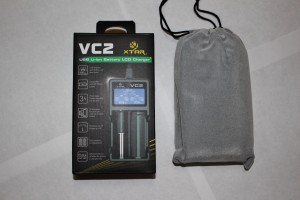
XTAR VC2 box and carrying pouch
The unit was housed in a smooth velvet-like pouch with a handy drawstring. Included was a USB charging cable, and instruction manual.
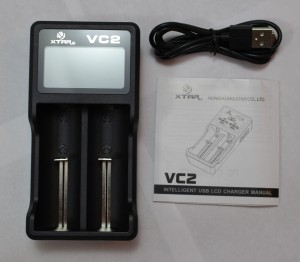
The VC2 accessory package
The unit features two spring loaded bays for charging a wide variety of battery sizes. The box (and backside of the charger) advertise 10440; 14500; 14650; 16340; 17670; 18350; 18490; 18500; 18650; 18700; 22650 and 26650.
Basic Charging
The XTAR VC2 has two independent charging bays. It uses a three-stage charging algorithm; TC-CC-CV.
The maximum charging current is 0.5 amps (500 mA) per battery. The unit will automatically select the maximum charging current based upon the input power. In layman’s terms here’s what I’ve observed.
When using the USB… and plugged into a computer for instance
- charging ONE battery: 500 mA
- charging TWO batteries: 350 mA
When using the USB… plugged into an AC wall adapter
- charging either ONE or TWO batteries: 500 mA
***click the accompanying image to view full size
So based upon this observation, batteries will charge FASTER when the USB connects with AC current.
When a full charge has been met, “full” will be displayed and the screen will flash three times every ten seconds.
No Trickling Required
The VC2 will charge each battery to 4.20 volts. The charging current will shut off when the peak voltage is reached. This differs from just about every other charger on the market… which provides a “trickle charge” once 4.2 is attained. But the VC2 will stop charging completely, thus not forcing the batteries to endure an extra charge, which they don’t appreciate.
Should you forget, and leave the batteries on the charger, the VC2 will begin applying extra voltage when the battery current drops below 3.90 volts. Theoretically they’d need to sit there for some time before that happens. I’m not sure if I would intentionally allow that to happen over and over, but this is the only charger I’ve ever seen that’s actually considered SAFE to allow it to happen in the first place!
Safety Precautions
The XTAR VC2 is pretty smart! Although I haven’t tried this… XTAR says that if a battery has reached **ZERO volts (or less than 2.0 volts)… (from being over-discharged) the VC2 will revive it! If the battery is too far gone to accept a charge, the unit will sense impending disaster, and shut off. The display will show “null”. This will be after about ten minutes of an attempted charge.
Soft Start
Falling under the banner of “safety precautions” is a feature known as Soft Start.
As the name implies, this is designed to not ‘jolt’ a battery with high current, that has been seriously depleted. For the sake of discussion we’re probably talking about one where the voltage is closer to 3.2 or lower. Generally speaking, lithium cells are said to be under greater stress when lower voltages are reached. So rather than stress the battery further with too much current at once, the VC2 will start a gradual (softer) charge. In this instance, the current will start closer to 350 mAh. It may or may not jump to 500 mAh before reaching termination.
I often let my batteries get close to 3 volts before a charge…and I’ve yet to see the VC2 activate that feature, but it may just be that the cells were healthy enough to not require it.
**A word of warning in this regard. Anyone schooled in lithium battery safety, will never, ever advise that a battery be (intentionally) discharged to below 3 volts. Unprotected batteries will allow this to occur, (unless they’re being used in a flashlight with voltage protection). But many batteries will suffer damage if permitted to discharge that low, and in some cases, making it dangerous to even ATTEMPT a charge thereafter. This is obviously where the VC2 can be helpful, by refusing to charge a battery that might of become damaged.
A Very Visual Display
The VC2’s display is a series of little “digital” dials.
With each battery inserted, the dial directly above the corresponding cell will display its current voltage… as it inches toward 4.2 volts.
Beneath that, is a counter showing mAh capacity. This is useful if the battery has been completely depleted. Because once finished, you’ll see exactly how much current went into the cell. If the resting voltage of the cell is anywhere from about 3.0 to 4.1, you’ll still get an mAh reading, but it won’t be the full capacity of the battery. This is the same reading you’d get when charging NiMH batteries on a dedicated NiMH charger.
In the photo where “0.5A” is circled, the unit is only charging one battery (on the left). The dial on the right is idyl, and the lone battery is getting 500 mAh. This is what it will do when the USB is plugged either into a computer, or to an AC outlet. The current will drop to 350 mAh if a second battery is added, AND if it’s charging via a computer. Car-charging is likely to deliver similar results.
Personal Experience
From testing and using the XTAR VC2 charger I can say with certainty that it’ll handle just about any lithium battery you can throw at it. The visual dials are well lit and easy to read.
Some experienced charger users might scoff at its 500 mA current limit. But if it takes an extra hour or two to charge a 3400 mAh 18650 battery, I say what does it matter? At least with the VC2 no harm can come to the battery by leaving it on the charger when it’s finished.
The XTAR VC2 lithium battery charger was provided for review by XTAR.
CLICK HERE to pick up the XTAR from Amazon.
Your questions and/or comments are also welcome 🙂





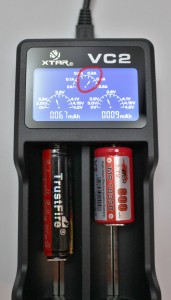

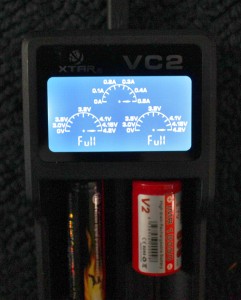
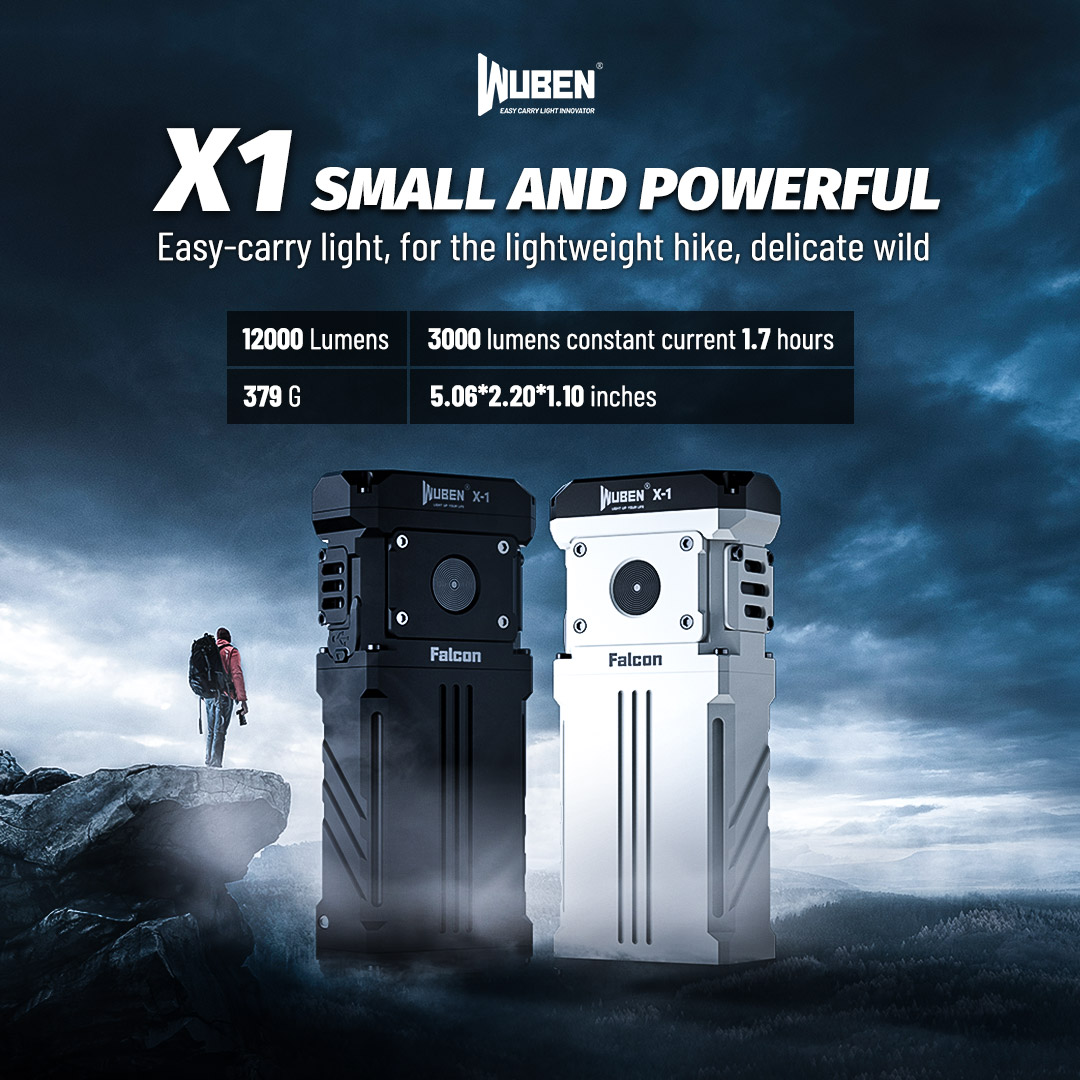
Very interesting. I have had problems in the past with my chargers – and also the rechargeable batteries too in all honesty.
I am the guy that fully charges up then 1 hour into my journey I am flat again.
This looks like a very good product. I will look more into it.
Thanks
Chris
Problems with chargers and batteries are often due to the equipment used. How soon they discharge depends on usage, cell capacity AND the quality of the batteries! Cheap batteries often have lower capacity, and won’t hold a charge nearly as long. Please refer to some of the posts in the Batteries section to learn about the proper care of lithium batteries, and the brands that need to be avoided at ALL costs!
Awesome! Glad I found this post! Lithium batteries sussed!
Thank you Steve!
Well reviewed product, I’ve had my share of issues with chargers and a few things that interest me here are:
Faster Charging
Usb Charging
Visual Display
Safety Precautions
Will look more into this, thanks for sharing.
Best wishes.
Ty
Glad you enjoyed the review Ty. While perhaps not being the fastest charger on the market, the XTAR covers the other attributes you mentioned very well…with safety being the most important.
Great review!! I’m looking for a 2 bay charger that will fit 2 26650s side by side. Have you tried it on the VC2?
Thanks for the question Vince!
YES, a VC2 will accept 2 – 26650’s…but its current is limited to 500mA. If that’s okay with you…then you can do it. But, just be aware that if your cells are around 5000mAh, they’ll take longer to charge in the VC2 due to the lower current. There might be other similar units that will accommodate those batteries, that might also be a bit faster, but I’m not aware of them. The only other ones I’d be able to recommend would be 4-bay units. Those are what I own the most of.
Take care!